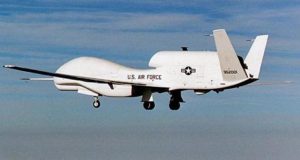|
Listen To The Article
|
Because there is too much money to be made and too many special interest groups that want them, drones are here to stay. Peter Singer of the Brookings Institution sees drones as a “game-changing technology, akin to gunpowder, the steam engine, the atomic bomb—opening up possibilities that were fiction a generation earlier but also opening up perils that were unknown a generation ago.”
 Before 2010 there was some small hope that the massive deployment of domestic drones could be avoided. That hope was lost when President Obama signed the FAA Reauthorization Act into law in 2012. Once reserved for the battlefields over Iraq and Afghanistan, the FAA opened up drone use for a wide range of domestic functions, both public and private. By 2020 there will be at least 30,000 drones occupying U.S airspace.
Before 2010 there was some small hope that the massive deployment of domestic drones could be avoided. That hope was lost when President Obama signed the FAA Reauthorization Act into law in 2012. Once reserved for the battlefields over Iraq and Afghanistan, the FAA opened up drone use for a wide range of domestic functions, both public and private. By 2020 there will be at least 30,000 drones occupying U.S airspace.
The kinds of drones that are popping up in U.S. skies are not the kind one expects after seeing Predators on the news. These are micro-sized craft that can go undetected as they hover above our cities and homes conducting 24/7 surveillance. Some of the kinds of drones becoming prevalent include:
Gorgon Stare Drones: A drone with sensors that can keep track of an area 2.5 miles across from twelve different angles.
Qube Drones: These are capable of hovering for forty minutes at heights of about 400 feet to conduct surveillance on targets as far as half a mile away.
Dragonfly Drones: The U.S. Air Force has “unveiled insect-sized spies ‘as tiny as bumblebees’ that cannot be detected and will be able to fly into buildings to ‘photograph, record, and even attack insurgents and terrorists.'”
Cyborg Drones: The Defense Advanced Research Projects Agency (DARPA) is developing a Micro-Electro-Mechanical System (MEMS) for the manipulation of insects into “cyborgs.” Through genetic engineering, they are seeking to control the movement of insects and utilize them for surveillance purposes.
Hummingbird Drones: Shaped like a bird, the “Nano Hummingbird” drone is slightly larger than an actual hummingbird and can rest in the palm of one’s hand. It flits around effortlessly, blending in with its surroundings.
Discover The Only Way Back To True Freedom And Liberty In America…
Nano Quadrators Drones: These small, four-propellered drones operate based upon the flight dynamics of insects, enabling them to operate as a swarm. Using twenty drones, researchers have demonstrated how, moving compactly as a unit, the drones were able to navigate obstacles, form complex patterns, and even execute a fluid figure eight arrangement.
Black Hornet Drones: Weighing in at roughly half an ounce and four inches long, comparable to a finch, the Black Hornet Nano helicopter drone was designed to capture and relay video and still images to remote users and can fly even in windy conditions.
Samarai Drones: Lockheed Martin’s tiny “Samarai” drone, inspired by the design of a maple seed, is capable of high speeds, low battery consumption, vertical movement, and swift ground deployment.
Spy-Butterfly Drones: Israel unveiled this insect-inspired drone, which they dubbed the “spy-butterfly” because of its two sizable wings. Weighing only twenty grams, this drone was developed for indoor surveillance in public places such as train stations, airport terminals, and office buildings. These virtually noiseless machines make them unnoticeable and therefore ideal for intelligence gathering.
Raven Drones: Weighing four pounds, the RQ-11 Raven drone is not as small nor as agile as its smaller counterparts, but with more than 19,000 out there already, it is the most common. Useful for seeing around corners and sending footage back to its handlers, the Raven resembles a rudimentary model airplane and crumbles like Legos upon landing.
With sixty-three active drone sites across the nation and fifty-six government agencies presently authorized to use drones, including twenty-two law enforcement agencies and twenty-four universities, drones are here to stay. As Singer, author of Wired for War, a book about military robotics, warns: “The debate over drones is like debating the merits of computers in 1979: They are here to stay, and the boom has barely begun. We are at the Wright Brothers Flier stage of this. There’s no stopping this technology. Anybody who thinks they can put this genie back in the box—that’s silliness.”
 Off The Grid News Better Ideas For Off The Grid Living
Off The Grid News Better Ideas For Off The Grid Living




